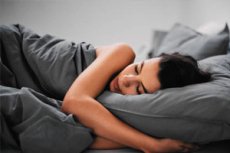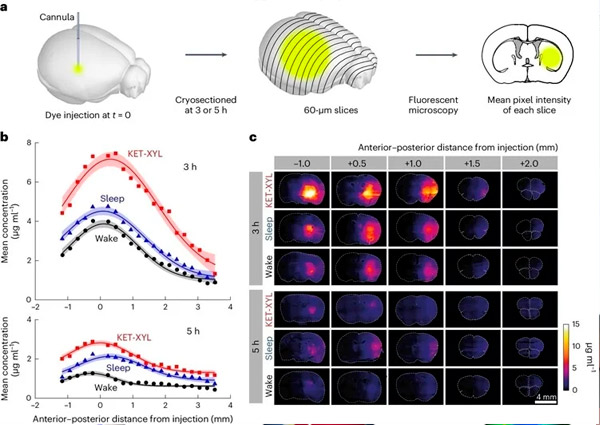
《自然神经科学》杂志最近发表的一项研究发现,麻醉和睡眠期间大脑清理会减少。
睡眠是一种脆弱的静止状态。鉴于这种脆弱性的风险,有人提出睡眠可能带来一些益处。有人提出,睡眠可以通过淋巴系统清除大脑中的毒素和代谢物。这一观点具有重要的意义;例如,长期睡眠不足导致毒素清除率降低可能会加重阿尔茨海默病。
大脑清除毒素和代谢物的机制和解剖学途径尚不清楚。根据类淋巴假说,在慢波睡眠期间,受动脉搏动产生的静水压力梯度驱动的基础液体流动会主动清除大脑中的盐分。此外,镇静剂量的麻醉药可以增强清除作用。睡眠是否通过增加基础液体流量来增强清除作用仍不清楚。
在这项研究中,研究人员测量了小鼠的液体运动和脑清除率。首先,他们确定了荧光染料异硫氰酸荧光素 (FITC)-葡聚糖的扩散系数。将 FITC-葡聚糖注射到尾状核中,并在额叶皮质中测量荧光。
初步实验包括等待染料达到稳定状态,在小体积组织中漂白染料,并通过测量未漂白染料进入漂白区域的移动速率来确定扩散系数。该技术通过测量FITC-葡聚糖在模拟大脑的琼脂糖凝胶中的扩散情况进行验证,该凝胶经过改良,以模拟大脑的光吸收和光散射。
结果表明,FITC-葡聚糖的扩散系数在麻醉和睡眠状态下并无差异。随后,研究小组测量了不同清醒状态下的脑清除率。他们在注射了生理盐水或麻醉剂的小鼠体内注入了少量荧光染料AF488。这种染料可以在脑实质内自由移动,有助于准确量化脑清除率。研究小组还对清醒和睡眠状态下的脑清除率进行了比较。
在峰浓度下,生理盐水处理小鼠的清除率为70%-80%,表明正常的清除机制未受损。然而,使用麻醉剂(戊巴比妥、右美托咪啶和氯胺酮-赛拉嗪)时,清除率显著降低。此外,与清醒小鼠相比,睡眠小鼠的清除率也降低。然而,麻醉状态和睡眠状态下的扩散系数并无显著差异。

A. AF488 注射至 CPu 后 3 至 5 小时,将脑组织冷冻并切成 60 μm 厚的冷冻切片。用荧光显微镜测量每张切片的平均荧光强度;然后取 4 张切片组的平均荧光强度平均值。
B. 使用补充图 1 中提供的校准数据将平均荧光强度转换为浓度,并绘制清醒(黑色)、睡眠(蓝色)和 KET-XYL 麻醉(红色)状态下注射点前后距离的图表。顶部是 3 小时的数据。底部是 5 小时的数据。线条表示数据的高斯拟合,误差线显示 95% 置信区间。在 3 小时和 5 小时,麻醉期间(3 小时 P < 10⁻⁶;5 小时 P < 10⁻⁶)和睡眠期间(3 小时 P = 0.0016;5 小时 P < 10⁻⁴)的 KET-XYL 浓度均显着高于清醒期间的浓度(双向方差分析,采用 Bonferroni-Holm 多重比较校正)。
C. AF488 注射部位不同距离(前后)的脑切片代表性图像,分别于注射后 3 小时(上三行)和 5 小时(下三行)进行。每行代表三种清醒状态(清醒、睡眠和 KET-XYL 麻醉)的数据。
研究发现,麻醉和睡眠期间脑清除率降低,这与先前的研究结果相矛盾。不同解剖部位的清除率可能存在差异,但差异程度可能较小。然而,氯胺酮-赛拉嗪对清除率的抑制作用显著,且与部位无关。
该研究的作者之一尼古拉斯·P·弗兰克斯 (Nicholas P. Franks) 表示:“研究领域一直将清洁作为我们睡眠的关键原因之一,因此我们对相反的结果感到非常惊讶。”
尤其值得注意的是,这些结果关注的是细胞外空间自由移动的少量染料。较大的分子可能表现出不同的行为。此外,睡眠和麻醉影响大脑清除的确切机制仍不清楚;然而,这些发现挑战了睡眠的主要功能是清除大脑中的毒素这一观点。

